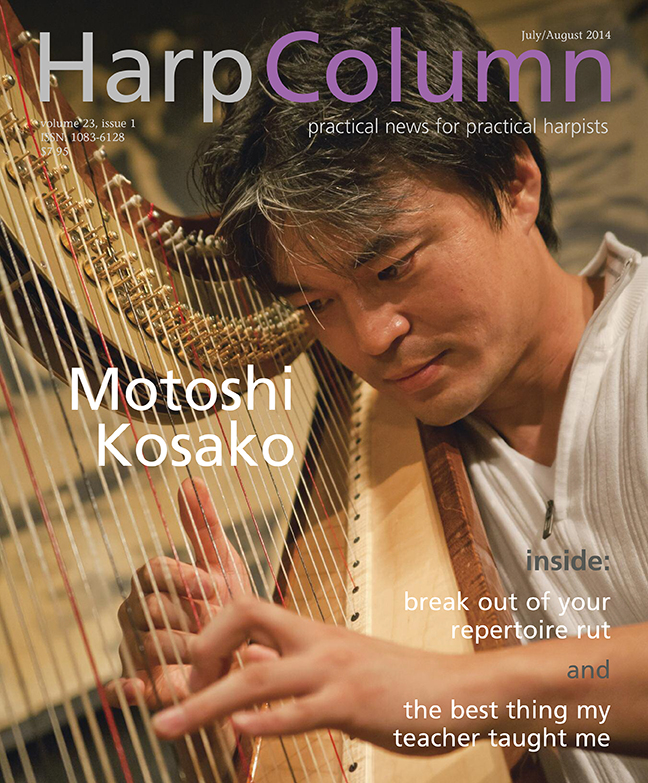- Entrada, by Frank Voltz
- Reflections, by Frank Voltz
- Frank Voltz adds three pieces to the Chiera Music library, highlighted by the “delightfully celebratory ‘Gloria!’”
- Forest Green, by Frank Voltz
- “This jazzy version of one of our most beautiful works is very appealing,” says Music Review Editor Jennings.
- Stephen Burtonwood’s original solo is “a welcome contribution for harp.
Lots of original compositions to add to your repertoire.
There are several new original works for both pedal and lever harp that are worthwhile additions to harp repertoire.
Frank Voltz has added some new pieces to his library of publications by Chiera Music for lever or pedal harp. The highlight of these recent additions is a delightfully celebratory piece, “Gloria!” This is an uplifting and joyful tune that makes a good wedding processional or recessional, or would be suitable for any occasion where you want to evoke a jubilant feeling. It is written in the key of G major and has only one pedal or lever change.
[protection_text]
It opens with a scale gliss, and there are several others throughout the piece. The left hand is mostly octaves, tenths, and some chords that duplicate the right hand chords. There are some scale patterns in the right hand. Intermediate players should be able to sight-read this music. The A-B-A form makes it easy to lengthen or shorten as needed.
He has also written “Entrada,” which means an expedition or journey into unexplored territory. The piece, written in C major, is similar in style to “Gloria!” with scale glisses and large chords played grandioso. Both these pieces have only occasional fingering suggestions, as they both fall very comfortably in the hands. “Entrada” has some large jumps, but no lever or pedal changes.
To honor the memory of his friend, Steve Green, the builder of Steen lever harps, Mr. Voltz offers Forest Green. It is a lively and lighthearted tune in D major with a Celtic flavor. It has an eight-bar theme that repeats with different left-hand embellishments. Fingering is suggested on the first presentation of the theme, but after that it is left up to the player to mark if needed. It is a lovely musical tribute and readily playable for the intermediate player.
For a change of pace, try “Reflections,” a relatively simple piece with a calming and peaceful character. Mr. Voltz adds harmonic interest by using seventh, ninth, eleventh, and thirteeth chords. This melody would be useful in a therapeutic or background music situation or wherever you want to set a relaxing mood. It is in F major, and like “Forest Green,” is completely diatonic.
All Chiera Music Publications are beautifully typeset and easy to read. Some page turns are a little challenging, but none are impossible. These selections will add some nice variety to your repertoire without requiring a large investment in practice time.
British composer Stephen Burtonwood has written a lyrical pedal harp solo, “Reverie.” In the past, Mr. Burtonwood’s writing has focused on sacred choral and organ music, but this contemporary piece is a welcome contribution for harp.
Published by Gotham Harp Publishing, it is only two pages in length and has a time signature that rotates between 6/8, 9/8, and 12/8. Pedal changes are clearly marked below the staff.
There is only one brief suggestion of fingering in measure 15, but there are several spots where fingering would be helpful. In measures eight and again at its recap in measure 24, it is more idiomatic to put the fourth-octave F that appears in the bass clef in the right hand. Although that is indicated by the upward stem, it would be much easier to read quickly if it were just added to the treble clef.
The biggest drawback to this music is that the typesetting is quite small and crowded, yet there are large white margins that would allow the music to expand and still fit on just two pages. With all the music notation software that is available today, this layout is unnecessarily taxing on the reader’s eyes.
Nevertheless, this is a lovely and enjoyable piece that is suitable for the intermediate pedal harpist. Don’t be discouraged by the scrunched typesetting—give it a try. Let’s hope he will write more for harp.
Maurice Ravel’s Introduction and Allegro is one of the most beloved standards in the harp repertoire. Now Cindy Horstman has published her original arrangement of the piece, “Fantasie on Ravel’s Introduction and Allegro” for two harps. Published by C. Horstman Music, it comes with separate parts for harps one and two as well as a score. This jazzy version of one of our most beautiful works is very appealing. You can hear it performed by Ms. Horstman on her website, www.cindyhorstman.com.
Harp one has a bit more to do than harp two, so it may be a little more difficult, although both harpists need to be able to count! The music is not difficult and would be suitable for intermediate to advanced players. Harp two has several harmonics and glisses. Both parts have several pedal changes and they are clearly marked below the staff.
If you have opportunities to play with two (or more) harps, this is fun and interesting to play. Harp ensembles could double up on the parts and the audience will surely enjoy this variation on Ravel. •
Jan Jennings is the music review editor for Harp Column and is the author of The Harpist’s Complete Wedding Guidebook and Effortless Glissing. You can email her at mail@harpbiz.com.













